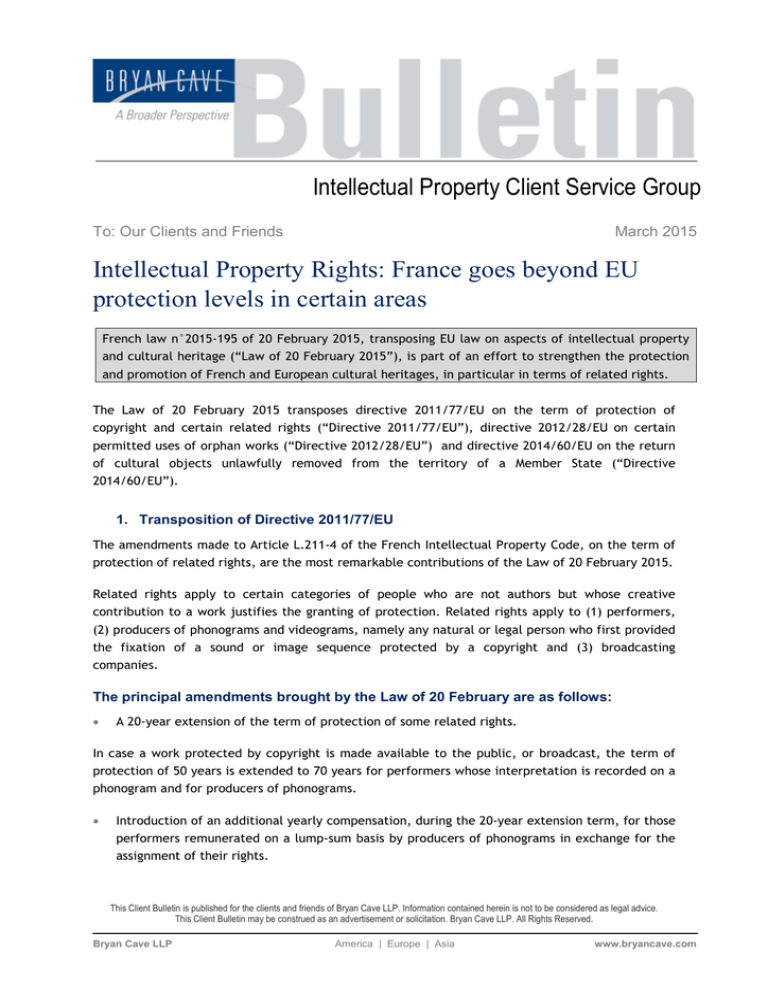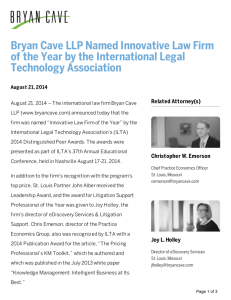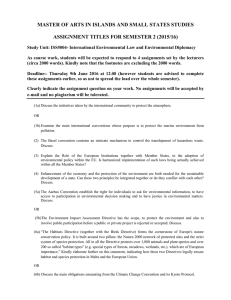
Intellectual Property Client Service Group
To: Our Clients and Friends
March 2015
Intellectual Property Rights: France goes beyond EU
protection levels in certain areas
French law n°2015-195 of 20 February 2015, transposing EU law on aspects of intellectual property
and cultural heritage (“Law of 20 February 2015”), is part of an effort to strengthen the protection
and promotion of French and European cultural heritages, in particular in terms of related rights.
The Law of 20 February 2015 transposes directive 2011/77/EU on the term of protection of
copyright and certain related rights (“Directive 2011/77/EU”), directive 2012/28/EU on certain
permitted uses of orphan works (“Directive 2012/28/EU”) and directive 2014/60/EU on the return
of cultural objects unlawfully removed from the territory of a Member State (“Directive
2014/60/EU”).
1. Transposition of Directive 2011/77/EU
The amendments made to Article L.211-4 of the French Intellectual Property Code, on the term of
protection of related rights, are the most remarkable contributions of the Law of 20 February 2015.
Related rights apply to certain categories of people who are not authors but whose creative
contribution to a work justifies the granting of protection. Related rights apply to (1) performers,
(2) producers of phonograms and videograms, namely any natural or legal person who first provided
the fixation of a sound or image sequence protected by a copyright and (3) broadcasting
companies.
The principal amendments brought by the Law of 20 February are as follows:
A 20-year extension of the term of protection of some related rights.
In case a work protected by copyright is made available to the public, or broadcast, the term of
protection of 50 years is extended to 70 years for performers whose interpretation is recorded on a
phonogram and for producers of phonograms.
Introduction of an additional yearly compensation, during the 20-year extension term, for those
performers remunerated on a lump-sum basis by producers of phonograms in exchange for the
assignment of their rights.
This Client Bulletin is published for the clients and friends of Bryan Cave LLP. Information contained herein is not to be considered as legal advice.
This Client Bulletin may be construed as an advertisement or solicitation. Bryan Cave LLP. All Rights Reserved.
Bryan Cave LLP
America | Europe | Asia
www.bryancave.com
This additional remuneration amounts to 20 % per year of the total revenue received by the
phonogram producer for the exploitation of the phonogram containing the authorized sound
fixation. However, the producers of phonograms with fewer than 10 employees and with a turnover
or annual balance sheet amounting to less than €2 million can be exempted from this additional
remuneration.
Introduction of the
possibility for a performer whose work is insufficiently exploited by a
phonogram producer during the term extension, to terminate the agreement whereby the
performer assigned his/her rights to the producer.
This is known as a “use it or lose it” system of protection.
The transposition into French law of Directive 2011/77/EU presents the following
benefits :
For performers, the extension of the term of protection of related rights will prevent having
the protection expire during the performers’ lifetime, thereby depriving them of remuneration
and of the possibility to object to the use of their work.
For the producers of phonograms, the extension of the term of protection of related rights will
bring about a better return on investment. This will hopefully promote the emergence of new
artists.
The additional yearly remuneration and the possibility of termination granted to performers
may well pave the way for more balanced contractual relationships between performers and
some of the bigger producers, which often prove to be lopsided.
Of particular interest is that the starting point of the protection of related rights, as from January
1st of the calendar year following the date when the work is made available to the public or
broadcast, is more favorable than what was provided by the Directive 2011/77/EU which set out
that the protection should be granted as from either of these two events, whichever is the earlier.
France therefore goes beyond EU protection requirements in this respect.
However, if the work is not broadcast nor made available to the public, the term of protection
remains unchanged, i.e. 50 years as from January 1st of the calendar year following the date when
the work was first interpreted or fixed on a phonogram. This 50-year term protection also remains
applicable to performers whose interpretations are recorded on a videogram, to the producers of
videograms and to broadcasting companies who remain out of the scope of the extension of the
term of protection.
2. Transposition of Directive 2012/28/EU
The Law of 20 February 2015 also transposes Directive 2012/28/EU, which provides how, under
certain conditions, an orphan work can be used and made available to the public. Orphan works are
those works still under protection of a copyright but whose rightsholder –provided diligent searches
have been conducted - could not be identified or located in order to obtain authorization for the
2
Bryan Cave LLP
America | Europe | Asia
www.bryancave.com
exploitation of the work. Public libraries will mainly benefit from these provisions allowing them to
make available to the public electronically orphan works contained in their archives. This opens up
the possibility to exploit works that otherwise would have been left aside.
3. Transposition of Directive 2014/60/EU
The transposition of Directive 2014/60/EU into French law has introduced provisions in the French
Code of Cultural Heritage aiming at facilitating the restitution of cultural objects considered by a
Member State to be national treasures and which have unlawfully been removed from its territory
since 1993. A system of cooperation between Member States has been set up so that the relevant
cultural object’s location can be identified, as well as its owner, possessor or holder. The system
also provides how to conduct return proceedings.
For m ore inform ationonthis subject,please contact the authors of this B ulletin,your contact
at B ryanCave or any m em ber of the IntellectualProperty Client Service G roup.
Joseph Sm allhoover,Partner,Paris
Direct Dial: +33 (0)1 44 17 77 10 / joseph.smallhoover@bryancave.com
Kathie Claret,Partner,Paris
Direct Dial: +33 (0)1 44 17 77 15 / kathie.claret@bryancave.com
François-Xavier M irza,A ssociate,Paris
Direct Dial: +33 (0)1 44 17 77 38 / francoisxavier.mirza@bryancave.com
B ryanCave alerts/bulletins/briefings are available online at w w w .bryancave.com /bulletins.
.
3
Bryan Cave LLP
America | Europe | Asia
www.bryancave.com



